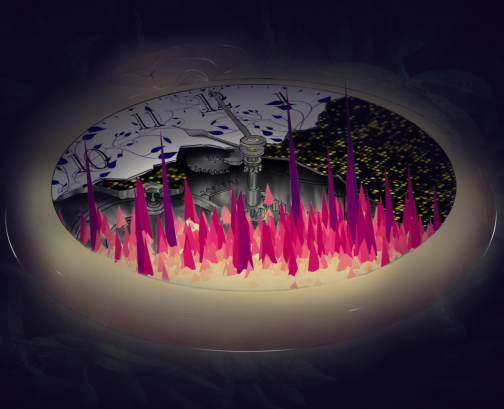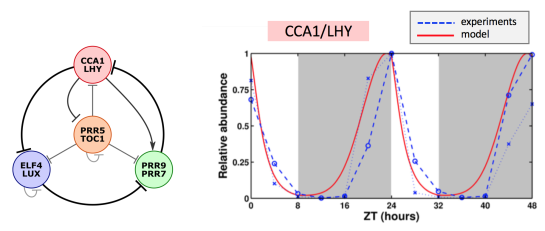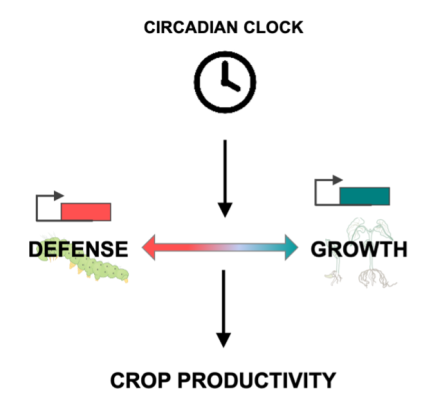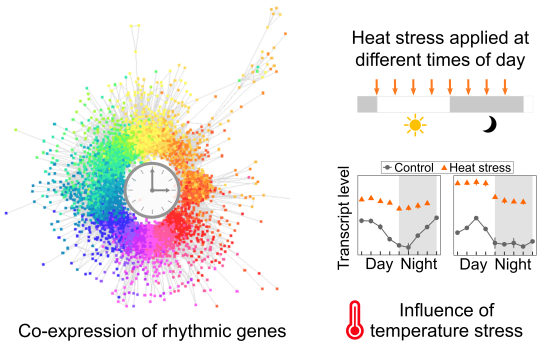The circadian clock and/or time of day regulation of cellular processes in a changing climate.
Program
09:00-09:10 Welcome
09:10-09:50 Dawn Nagel, University of California, Riverside, USA
Coordination between time of day and temperature stress responses in plants.
09:50-10:30 Devang Mehta, Katholieke Universiteit Leuven, Belgium
Closing gaps in plant chronobiology: from genome to proteome and from molecules to future geographies.
10:30-11:10 Didier Gonze, Université de Bruxelles, Belgium
The plant circadian clock: Insights from computational modeling.
11:10-11:50 Maria Nohales, Instituto de Biología Molecular y Celular de Plantas, IBMCP (CSIC-UPV), Valencia, Spain
Time to act: Circadian regulation of plant-environment interactions.
11:50-12:30 Titouan Bonnot, INRAE, Agroecologie, Dijon, France
Considering the influence of time of day to identify candidate regulators of plant thermotolerance.
Abstracts:
Dawn Nagel, University of California, Riverside, USA
Coordination between time of day and temperature stress responses in plants.
As the temperature fluctuates throughout the day, understanding how plants modulate their molecular responses to moderate and growth-limiting temperatures depending on the time of day is critically important. Our recent work shows that the time-of-day gates the response to temperature stress in plants including at different levels of gene regulation. Furthermore, at the transcriptome level, the molecular dynamics depend on the genotype sensitivity in some plants. We are characterizing selected genes whose basal expression is confined to specific periods of the day but whose heat responsiveness depends on the time of day to better capture the temporal dynamics of stress responses. By tweaking interactions in the network at different times of the day, we hope to generate dynamic stress-resilient plants.
Devang Mehta, Katholieke Universiteit Leuven, Belgium
Closing gaps in plant chronobiology: from genome to proteome and from molecules to future geographies.
Climate-change is causing global shifts in crop production, with a gradual northward shift in the growing regions of many plants. Previous research by us and others has found that plants use their circadian clock to sense changes in their geographical environment, such as differences in light intensity and quality to shape their growth and development. As climate change forces agriculture to expand into more Northern latitudes, we need to understand how the clock functions in different environments and how we can tweak it to engineer future-proof crops. We know from decades of fundamental research that the circadian clock in plants consists of highly interconnected transcriptional-translational feedback loops that control the expression of approximately 40% of all genes. However, little is yet known about how these rhythms in transcription translate to rhythmic protein expression. By developing new quantitative proteomics technology, we have produced the first circadian protein atlas in plants, providing unprecedented global insight into the timing of gene expression by the clock. My new research group at KU Leuven will use such new-omics approaches to characterize plant chronobiology under different simulated environmental conditions with the aim of engineering latitudinal adaptability in plants.

Didier Gonze, Université de Bruxelles, Belgium
The plant circadian clock: Insights from computational modeling.
The molecular mechanism underlying circadian rhythms in plants involves interlocked transcriptional feedback loops and multiple light inputs. Over the last decade, mathematical models of increasing complexity have been used to understand the inner workings of the clock in Arabidopsis thaliana. I will show how these models contribute to identify key circadian regulators, provide insights on the complexity of the regulatory network and its role in photoperiodic adaptation, and help to unravel molecular mechanisms by which the circadian clock responds to external perturbations (such as magnesium deficiency).

Maria Nohales, Instituto de Biología Molecular y Celular de Plantas, IBMCP (CSIC-UPV), Valencia, Spain
Time to act: Circadian regulation of plant-environment interactions.
Food security and sustainable agriculture are at the center of the 2030 Agenda for Sustainable Development (https://sdgs.un.org/2030agenda). The prediction of adverse climate conditions for the coming years together with the estimates of world population growth prompt a quantitative increase in the efficiency of agricultural production to maximize yield under unfavorable conditions (http://www.fao.org/publications/card/en/c/d24d2507-41d9-4ec2-a3f8-88a489bfe1ad).
A core molecular network that enhances plants’ fitness and survival in fluctuating environments is the circadian clock and substantial evidence supports a role for this internal timekeeping mechanism in modulating the ability of plants to tolerate and acclimate to different types of environmental stresses. However, knowledge on the actual molecular connections between the central oscillator and the response to environmental challenges is limited.
In the lab, we are interested in characterizing the molecular mechanisms by which the clock modulates specific output pathways of interest, such as growth-defense trade-offs, in both model and crop species. The ultimate goal will be to leverage this information towards the improvement of crop yield and performance in the field.

Titouan Bonnot, INRAE, Agroecologie, Dijon, France
Considering the influence of time of day to identify candidate regulators of plant thermotolerance.
To better attune with their environment, plants partition specific responses to the most optimal times of the day. This can be observed at gene expression level, where a large proportion of genes exhibit rhythmic expression, with 24-h oscillations. For example, there is a significant over-representation of genes with a peak of expression around dawn within genes involved in photosynthesis. This regulation involves the coordination between environmental signals, the circadian clock, internal cellular processes, and biological outputs. Under stresses, priorities for gene transcription and translation of the corresponding mRNAs are redefined to induce the cellular responses. In Arabidopsis, we showed that about one-third of the circadian-regulated heat-responsive translatome is responding to heat in a time-of-day specific manner. For these genes, the magnitude of response to stress differs depending on the time of the day, a phenomenon referred to as gating. We observed this effect in similar proportion at the transcriptome level in sorghum. We showed that the gating response to temperature stress can be explained by the gene expression rhythmicity, but not only, as non-rhythmic genes are also gated. During this talk, we will discuss the importance of considering these effects when identifying candidate regulators of plant thermotolerance.

